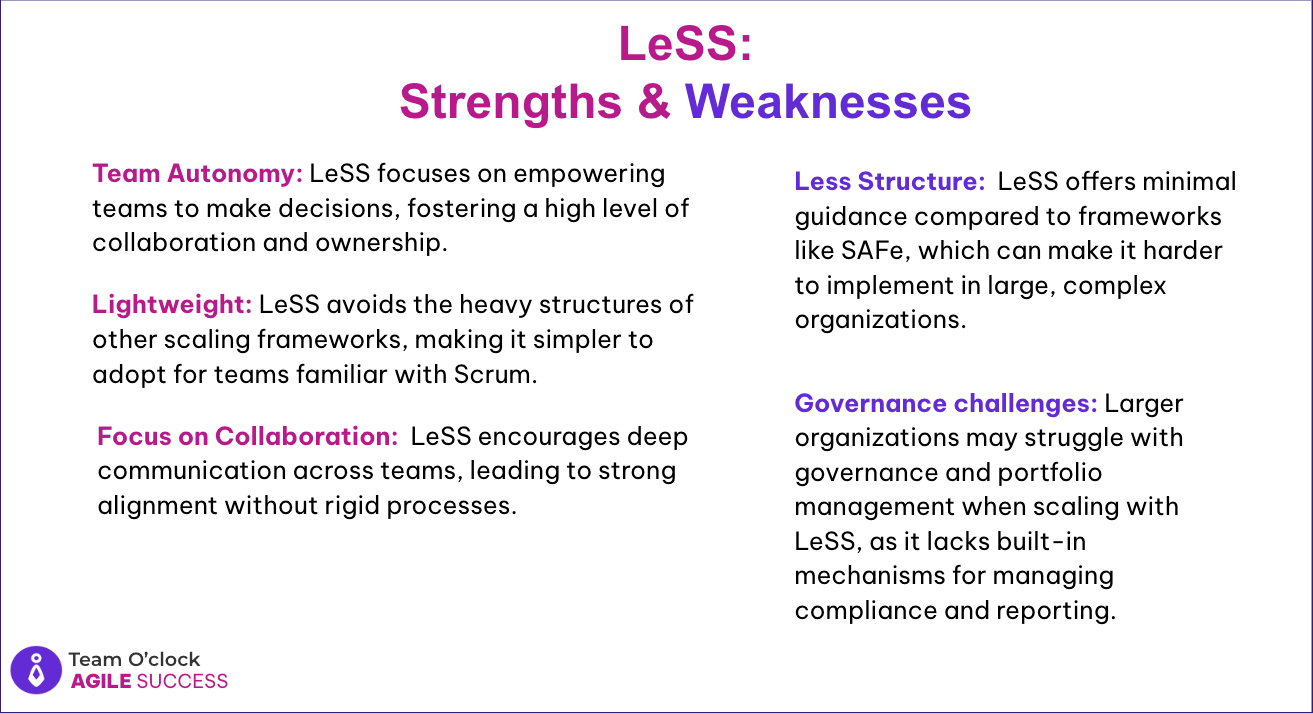
What To Know About The Emerging Agile Frameworks: SAFe VS LeSS

Agile methodologies have become a staple in how teams collaborate, deliver value, and respond to change. However, scaling Agile beyond individual teams becomes necessary as organizations grow to maintain efficiency and alignment. This is where Agile scaling frameworks like SAFe (Scaled Agile Framework) and LeSS (Large-Scale Scrum) come into play.
Both SAFe and LeSS offer solutions to help larger organizations scale Agile practices across multiple teams, but each takes a distinct approach. In this blog, we’ll provide an unbiased comparison of SAFe and LeSS to help you determine which framework best suits your organization.
What is SAFe (Scaled Agile Framework)?
SAFe is a comprehensive framework designed to scale Agile principles across large organizations. It provides structured guidance for delivering value in a coordinated, multi-team environment, ensuring alignment between teams, departments, and broader business goals.
The Core Components of SAFe
SAFe offers four configuration levels based on the organization’s size and complexity:
Essential SAFe: The most straightforward configuration, focusing on Agile Release Trains (ARTs) and team-level practices.
Large Solution SAFe: Used for developing large, complex solutions requiring coordination across multiple ARTs.
Portfolio SAFe: Aligns ARTs with the organization’s strategic goals, providing guidance for portfolio management.
Full SAFe: A complete configuration, including all levels, used by the largest enterprises.
Key roles in SAFe include:
the Release Train Engineer (RTE), who facilitates coordination across teams,
the Product Owner, who is responsible for managing the backlog and
the System Architect, who oversees technical alignment.
SAFe emphasizes aligning all teams through program increments (PIs), ensuring everyone works toward the same objectives in a coordinated cadence.
The Strengths & Limitations of SAFe

What is LeSS (Large-Scale Scrum)?
LeSS is a lightweight scaling framework that focuses on maintaining Scrum's simplicity and core principles, even at scale. Unlike SAFe, which introduces new roles and structures, LeSS keeps the Scrum approach intact, scaling it across multiple teams working on the same product.
The Core Components of LeSS
LeSS consists of two frameworks:
Basic LeSS: Designed for up to eight Scrum teams working on the same product.
LeSS Huge: Intended for large-scale implementations involving more than eight teams, with additional structure to coordinate across multiple product areas.
LeSS retains Scrum’s core roles, such as the Scrum Master and Product Owner, without adding extra layers of hierarchy. One key feature is the shared product backlog across all teams, ensuring alignment while promoting autonomy and collaboration. Teams work independently but coordinate closely through frequent communication.
The Strengths & Limitations of LeSS:

What Are the Key Differences Between SAFe and LeSS?
Aspect | SAFe (Scaled Agile Framework) | LeSS (Large Scale Scrum) |
Approach to Scaling | Top-down, prescriptive approach. Multiple layers of hierarchy and governance ensure alignment with strategic goals. | Bottom-up approach. Prioritizes team autonomy and minimizes additional structures to maintain Scrum's lightweight nature. |
Roles and Responsibilities | Introduces new roles (e.g., Release Train Engineer, System Architect) for team oversight and alignment. | Maintains Scrum's original roles with no added layers of hierarchy. Emphasizes shared responsibility across teams. |
Team Autonomy vs. Governance | Focuses on governance and alignment with business strategy, limiting individual team autonomy. | Emphasizes team autonomy, minimizing governance. It is ideal for flexible teams but challenging for managing complex dependencies and compliance. |
When to Choose SAFe
SAFe is a good fit for organizations that:
Are large and complex: If your organization has multiple teams and complex hierarchies, SAFe provides the structure needed to scale effectively.
Need governance and compliance: SAFe’s built-in processes make it easier to manage governance and compliance in industries where regulatory oversight is essential.
Require clear alignment with business goals: For organizations that must ensure all Agile efforts are aligned with broader company objectives, SAFe’s focus on program increments and strategic alignment is ideal.
When to Choose LeSS
LeSS works best for organizations that:
Value simplicity and flexibility: If your organization wants to maintain Scrum’s lightweight nature while scaling, LeSS offers a minimalistic approach that avoids the complexity of frameworks like SAFe.
Have fewer hierarchical layers: LeSS is ideal for organizations that prioritize cross-team collaboration over top-down governance.
Favor team autonomy: If your teams thrive in a self-managed environment and prefer to make their own decisions, LeSS offers the flexibility they need.
Takeaway
Both SAFe and LeSS offer valuable frameworks for scaling Agile, but each serves different organizational needs. SAFe is ideal for large enterprises with complex structures, providing the governance and alignment necessary for large-scale implementations.
On the other hand, LeSS is perfect for organizations that want to maintain Scrum's simplicity and flexibility while scaling.
When choosing between SAFe and LeSS, consider your organization’s size, culture, and strategic goals. Whichever framework you choose, remember that Agile is about adaptability—don’t hesitate to experiment, learn, and iterate based on what works best for your teams.
Discover more Agile solutions from Team O’Clock and try them out with our 15-day free trial.








